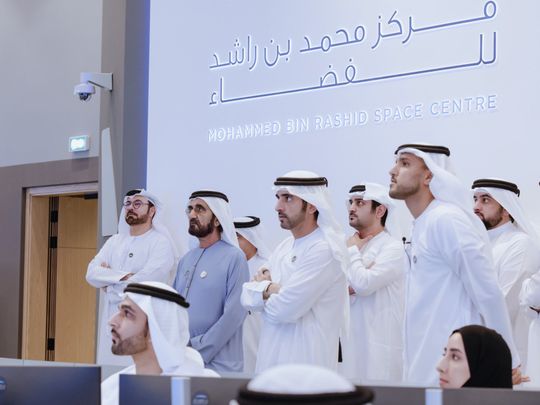
Dubai: The UAE’s and the Arab world’s first journey to land on the Moon began successfully on Sunday, with the triumphant launch of Emirati-made Rashid Rover aboard a Japanese lunar lander sent to space on a SpaceX Falcon 9 rocket from Cape Canaveral Space Force Station in Florida, USA.
Lift-off was at 11.38am (UAE time) on December 11, and the lunar lander carrying Rashid Rover is on its way for a five-month, fuel-saving 384,400km journey to the surface of the Moon.
His Highness Sheikh Mohammed bin Rashid Al Maktoum, UAE Vice President and Prime Minister and Ruler of Dubai; Sheikh Hamdan bin Mohammed bin Rashid Al Maktoum, Crown Prince of Dubai; and Sheikh Maktoum bin Mohammed bin Rashid Al Maktoum, Deputy Ruler of Dubai, were at the Mission Control Centre inside the Mohammed bin Rashid Space Centre (MBRSC) in Dubai to witness the historic launch of Rashid Rover.
‘UAE to share knowledge’
Tweeting on the occasion, Sheikh Mohammed said: “Rashid Rover is part of an ambitious space program in the UAE. We started with Mars and now moving to the moon while eying Venus. Our goal is to share knowledge, develop our capabilities, and add a scientific footprint in human history.”
He added: “Reaching the Moon is yet another step forward in the UAE’s ambitious journey. The aspirations of Emirati people are boundless and nothing can hold them back. The best is still to come.”
“The UAE launched Rashid Rover today in preparation for a lunar landing. We will be the fourth nation in the world and the first Arab country to set foot on the Moon’s surface if the mission is successfully completed,” Sheikh Mohammed continued.
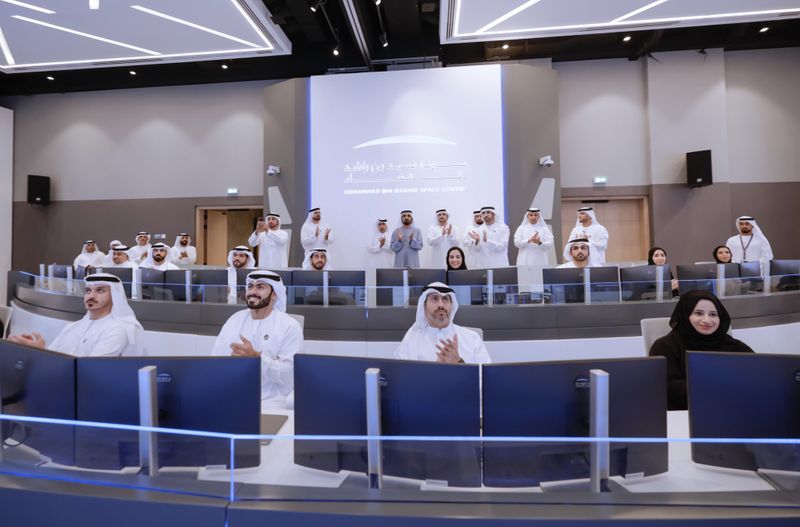
From desert dunes to lunar surface
Born from the desert dunes of the UAE, Rashid Rover — named after the late Sheikh Rashid bin Saeed Al Maktoum, builder of modern Dubai — will study the characteristics of lunar soil, the petrography (composition and properties of lunar rocks) and geology of the Moon. It will also take photos of the moon’s dust movement, surface plasma conditions, and the lunar regolith (blanket of superficial deposits covering solid rocks).
The Japanese-made lunar lander Hakuto-R carrying Rashid Rover will land on Atlas Crater, located at 47.5°N, 44.4°E on the Moon’s southeastern outer edge of Mare Frigoris (Sea of Cold). Atlas Crater has a diameter of 88 kilometres, believed to have been formed between 3.2 to 3.8 billion years ago. It is circular in shape and bounded by an intricately terraced rim wall. The crater is 2km deep and has a complex floor covered in hills and cracks.
It is there where Rashid Rover will capture photos and collect information of the unexplored Moon crater.
According to MBRSC, Rashid Rover will provide about 10 gigabytes of recorded material, scientific data and new images to the global scientific community.
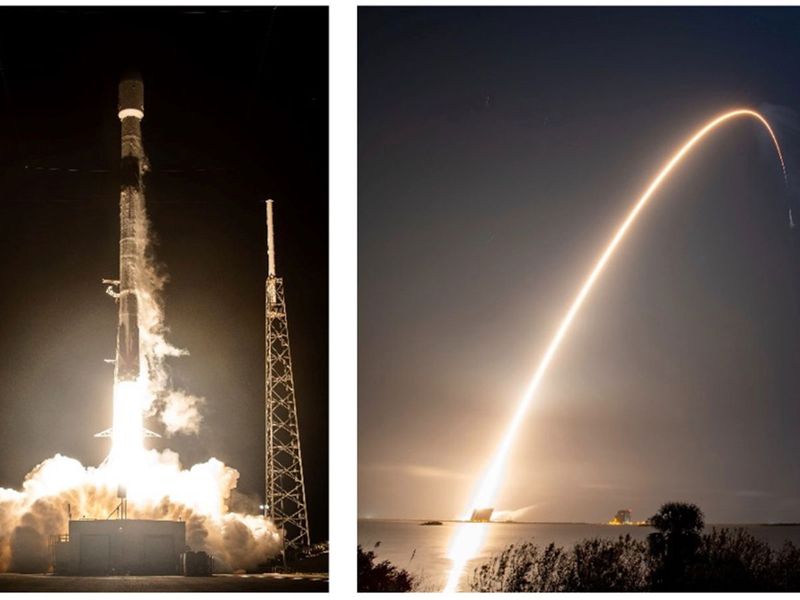
Ahead of schedule
The launch of the Emirati-made compact lunar rover has been postponed thrice — first on November 28; second on November 30 and December 1 — to allow for additional preflight checks of the launch vehicle (SpaceX Falcon 9 rocket).
Rashid Rover, however, was actually delivered well ahead of the original 2024 deadline. Sheikh Mohammed first announced Rashid Rover in September 2020, and the initial goal was to land it on the Moon by 2024.
‘Made with our own hands’
No one was more excited for the launch of Rashid Rover than the group of Emirati engineers who built Rashid Rover from scratch with their own hands.
Speaking to Gulf News hours before the launch on Sunday, Abdulla AlShehhi, Rover Mechanical Engineering Lead, said: “We are very excited for the launch of the first mission by the UAE to land on the Moon. We built Rashid Rover with our own hands and if you have built something with your own hands and you see the name of the UAE on it and it will go to the Moon, the feeling is really indescribable.”
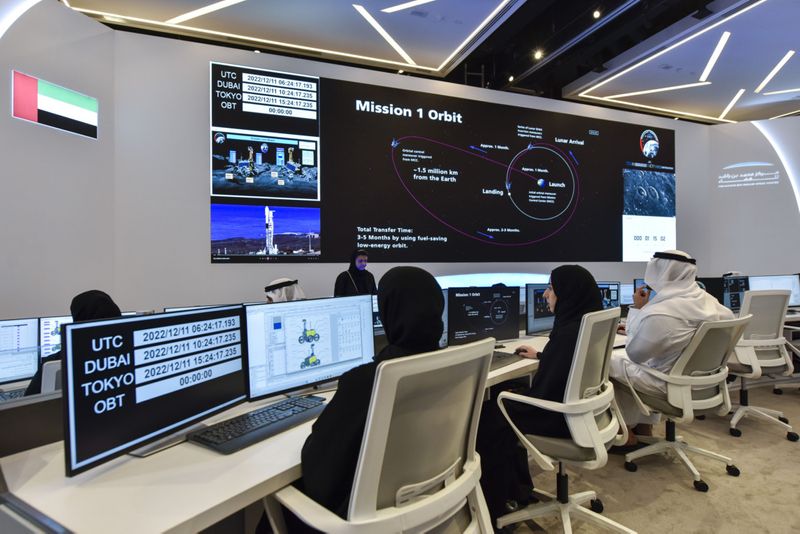
Small but powerful
Designed and developed fully by an Emirati team, Rashid Rover is touted as the world’s most compact rover that could land on the Moon. Its height is 70cm, length is 50cm and width is 50cm. Its weight is approximately 10kg with payload, but it can climb over an obstacle up to 10cm tall and descend a 20-degree slope.
Rashid Rover has 3D cameras, advanced motion system sensors and communication system that are powered by solar panels. There are four cameras that move vertically and horizontally, including the two main cameras, which are Caspex (camera for space exploration) that can withstand vibrations during launch and landing
Engineers at MBRSC went through five modules until they reached with the final flight model that was launched on Sunday.
AlShehhi explained: “We have done a lot of preparation for the launch — from creating simple to complex engineering models and conducting several rounds of test to ensure a safe journey to the Moon.”
According to plan
The launch was a success and it happened according to plan. Dimitra Atri, astrophysicist at New York University in Abu Dhabi, praised the UAE and its burgeoning space programme. He told Gulf News: “Planetary exploration using rovers is technically challenging and the fact that Rashid Rover was built in the UAE demonstrates the capabilities and ambitions of a country with a very young but rapidly growing space program. If successful, the UAE, along with Japan will become the fourth country in space exploration history to successfully land on the Moon after the United States, former Soviet Union and China.
Long but economic route
The Japanese-made lunar lander carrying Rashid Rover and other payload to the Moon will take a low-energy route to the Moon rather than a direct approach. This means the landing on the Moon will take about five months after launch, in April 2023.
Dr Hamad Al Marzooqi, project manager of Emirates Lunar Mission at MBRSC, earlier told Gulf News the rationale for the fuel-saving but long route. He said: “The main factor is the cost of the mission. The cost comes from the volume and mass of the spacecraft. In order to reach to the moon within six days — which is the shortest path — you would need to burn a lot of fuel which means that you need a big tank and a big propulsion system to do that.”
“But it will have a huge impact in cost so, in order to reduce the cost of the mission, ispace (our partner) has selected their approach that they can reach to the lunar surface within five months but it will be less costly because it will burn much less fuel. They will use a smaller tank and propulsion system, therefore the launch cost and the cost of developing the developing system will be lower,” he further explained.
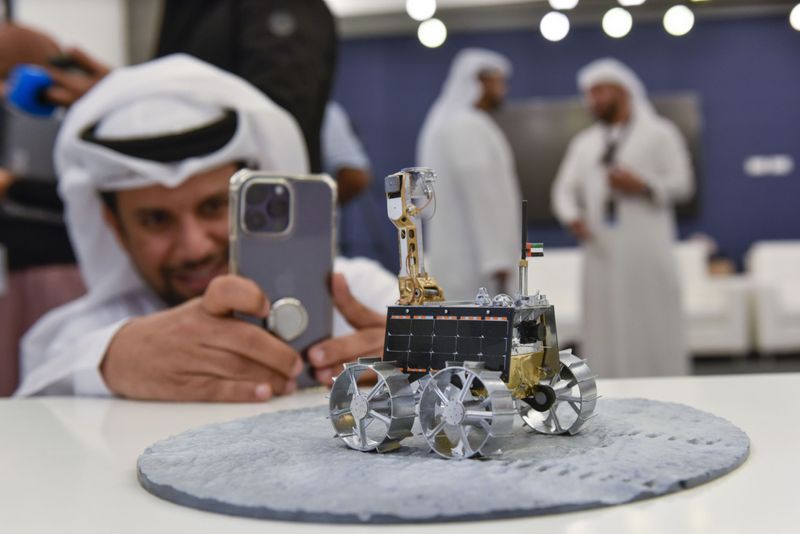
Challenging landing
Hakuto-R will use the gravitational pull of the Earth and sun to guide it to the Moon. As it gets closer to the lunar surface, the Japanese-made lander will first orbit the moon with an increasingly elliptical trajectory, before angling itself vertically to softly land on the moon and perform a fully-automated landing. This is the most critical part of the lunar mission, with several missions having failed before, including that of India and Israel.
“The most critical part would be the landing phase but we have prepared Rashid Rover to sustain the shock load. We have tested all types of materials until we reached with the final flight model that is placed inside the Hakuto-R lander,” AlShehhi assured.
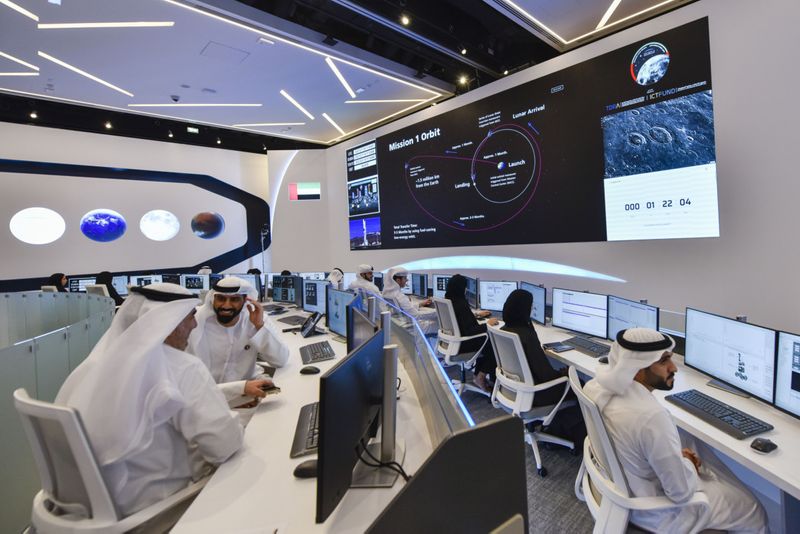
Lunar payload
Aside from Rashid Rover, the one-ton robotic Hakuto-R lander is also carrying other payloads to the Moon, including a transformable lunar robot from Japan Aerospace Exploration Agency; a test module for a solid-state battery from NGK Spark Plug Co., Ltd., an artificial intelligence (AI) flight computer from Mission Control Space Services Inc., a multiple 360-degree camera from Canadensys Aerospace, a panel engraved with the names of Hakuto crowdfunding supporters, and a music disc containing the song ‘Sorato’ played by Japanese rock band Sakanaction.
Hakuto-R M1 will establish a steady telecommunication and power supply on the lunar surface after landing to support customer payload’s surface operations, including that of the Rashid Rover.
Mission period
Rashid Rover will study the Moon’s surroundings for one lunar day, which is equivalent to 14 days on Earth. But there is a chance Rashid Rover’s mission can be extended to another lunar day. Al Marzooqi explained earlier: “After the first lunar day the rover will go into a hibernation or mode sleep during the (lunar) night (which is also equivalent to 14 Earth nights) until the sun rises again and the temperature on the rover surface starts to rise again. And by that time, the team will try to “wake up” Rashid Rover to see if its systems were able to survive the low temperatures and ready for the second lunar day.

Harsh lunar environment
The Moon environment is very harsh. Its temperature drops to as low as minus 173 degrees Celsius, from as high as 127 degrees Celsius, when sunlight hits the Moon’s surface. But Rashid Rover is equipped with the latest technologies that can resist the lunar surface temperature.
One-way trip
Rashid Rover will not return to Earth. It’s a one-way flight and there is no transport that will bring back Rashid Rover and Hakuto-R. What Rashid Rover will bring back to Earth are multiple images — around 10 gigabytes of recorded material and scientific data. The ELM team at MBRSC will use these to test new technologies in material science, robotics, mobility, navigation and communications. The findings will also help in the design of future missions to survive and function in harsh space environment.
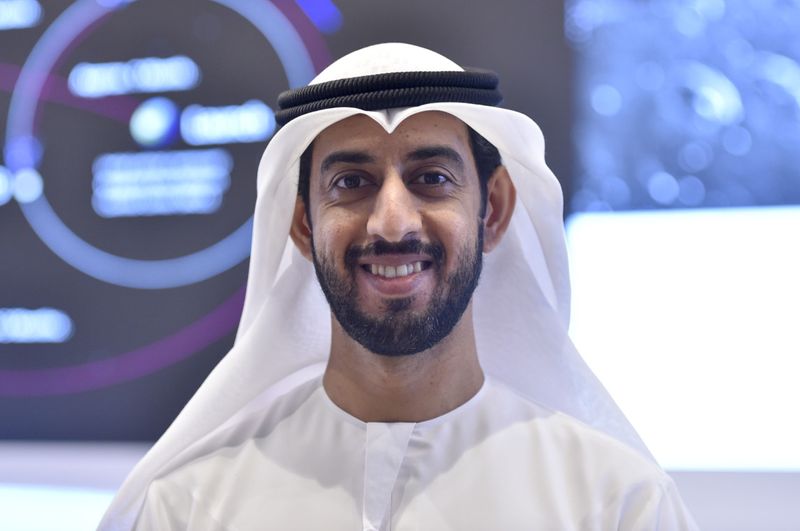
More lunar missions
Rashid Rover is on its way to the Moon, carrying with it the pride and dreams of the UAE — and the entire Arab world. It is first of the UAE’s multiple missions to the Moon. Back in September this year, MBRSC signed an agreement with China National Space Administration (CNSA) to kick start joint space projects and future lunar exploration, including sending the next UAE rover aboard Chang’e 7, a robotic Chinese lunar exploration mission expected to be launched in 2026 to target the Moon’s south pole.
Launch timeline
Lift-off was at 11.38am (UAE time)
T+00:00: Lift-off
T+01:12: Maximum aerodynamic pressure (Max-Q)
T+02:13: First stage main engine cut-off (MECO)
T+02:17: Stage separation
T+02:24: Second stage engine ignition
T+02:29: First stage boost back burn ignition (three engines)
T+03:06: Payload fairing jettison
T+03:26: First stage boost back burn cut-off
T+06:33: First stage entry burn ignition (three engines)
T+06:53: First stage entry burn cut-off
T+07:44: First stage landing burn ignition (one engine)
T+07:52: Second stage engine cut-off (SECO 1)
T+08:16: First stage landing
T+40:02: Second stage engine restart
T+40:58: Second stage engine cut-off (SECO 2)
T+46:59: Hakuto-R spacecraft separation; cruise to the Moon begins
Numbers
11.38am, December 11, 2002 — UAE-made Rashid Rover flies to the Moon
384,400 — space journey of Hakuto-R lander carrying Rashid Rover and other payload to the lunar surface
5 — months after launch, Rashid Rover is expected to land on the Moon in April next year
September 2020 — Rashid Rover project was announced with initial goal to land it on the Moon by 2024
1 lunar day/ 14 Earth days — Mission period of Rashid Rover to take pictures and study the lunar surface
Minus 173 degrees/ 127 degrees Celsius — coldest and hottest temperatures on lunar surface
70, 50, 50 — height, length and width of Rashid Rover in centimetres
10kg — weight of Rashid Rover, including its built-in cameras
1st — with the successful landing of Rashid Rover, the UAE will become the first Arab country to land on the Moon












